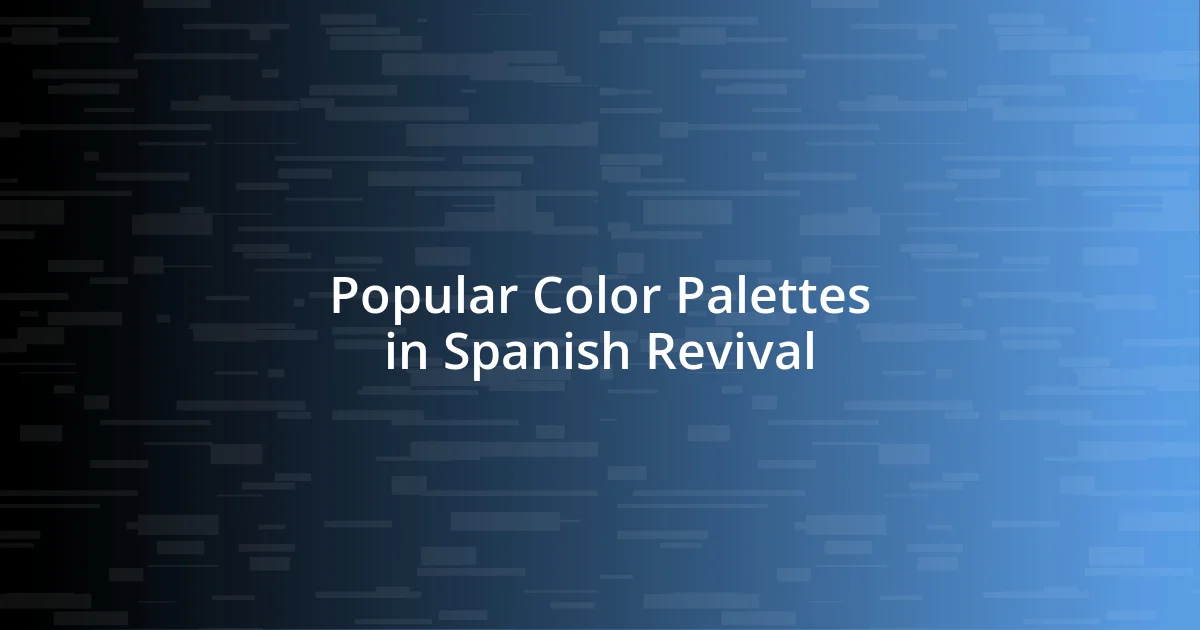Key takeaways:
- Spanish Revival aesthetics blend old-world charm with modern elements, evoking a sense of warmth, creativity, and community.
- Key characteristics include vibrant tile work, arched doorways, and earthy color palettes that create inviting and serene spaces.
- Accessorizing and designing both indoor and outdoor areas with thoughtful textures and colors can enhance the Spanish Revival experience, turning spaces into cherished retreats.

Introduction to Spanish Revival
Spanish Revival aesthetics, with their distinctive blend of old-world charm and vibrant elements, take me back to my travels in southern California. The intricate tile work and arched doorways felt like stepping into a sun-drenched dream—there’s something truly enchanting about the way this style captures the essence of Spanish history and culture. Have you ever wandered through a neighborhood that felt like a portal to another time?
The movement emerged in the early 20th century, drawing inspiration from Spanish colonial architecture while infusing it with modern sensibilities. This eclectic approach resonates with me because it bridges the past and present so seamlessly. Each home tells a story, echoing the artistry of artisans who meticulously crafted every detail, from wrought-iron railings to colorful stucco exteriors.
What I find fascinating is how Spanish Revival is more than just a style; it’s an emotional experience. It evokes warmth, creativity, and a sense of community that’s hard to replicate. Just think about how a beautifully designed courtyard can draw people together—don’t you feel a sense of connection when gathered in such inviting spaces? That’s the magic of Spanish Revival.

Key Characteristics of Spanish Revival
The key characteristics of Spanish Revival are truly captivating, reflecting an era where craftsmanship and artistry flourished. One notable feature is the use of vibrant, hand-painted tiles, often seen in kitchen backsplashes or outdoor patios. I can still recall admiring the intricate patterns during a visit to a local home, feeling as if the tiles were telling stories of their own, each color vividly representing moments in time.
Arched doorways and windows also play a significant role in this aesthetic, evoking a sense of warmth and intimacy. I remember strolling through a picturesque street lined with these stunning architectural details, and it felt like each arch was a welcoming embrace. This feature not only enhances visual appeal but also invites light and air into the spaces—it’s an experience of sheer joy to stand beneath those archways on a sunlit day.
Another distinctive element is the earthy color palette, often utilizing terracotta, soft yellows, and muted oranges that reflect the warmth of the Mediterranean. When I first walked into a home adorned with such colors, it felt like stepping into a cozy hug. These hues evoke feelings of serenity and timelessness, making them perfect for creating inviting and comfortable environments. The blend of these characteristics forms a harmonious balance that truly defines Spanish Revival aesthetics.
| Characteristic | Description |
|---|---|
| Vibrant Tile Work | Hand-painted tiles with intricate designs often used in kitchens and patios. |
| Arched Doorways & Windows | Architectural features that create warmth and welcomed light into spaces. |
| Earthy Color Palette | Soft yellows, terracotta, and muted oranges evoke a Mediterranean feel. |

Popular Color Palettes in Spanish Revival
The color palettes commonly seen in Spanish Revival deeply resonate with my appreciation for warmth and vibrancy. I have always been captivated by how these colors seem to sing together, much like a lively fiesta. For instance, the stunning combination of deep blues, vibrant reds, and sun-kissed yellows can transform any space into an inviting, joyous retreat. I remember stepping into a courtyard one afternoon, where the bright colors of the flowers against the neutral stucco walls created an uplifting environment that invited my friends and me to linger a little longer, sharing stories and laughter.
Here are some popular color palettes often found in Spanish Revival aesthetics:
- Earthy Tones: Terracotta and sandy beiges mimic the natural landscape, offering a grounding feel.
- Jewel Tones: Rich shades of emerald greens, deep blues, and ruby reds add a sense of luxury and depth.
- Pastel Colors: Soft lavenders, blush pinks, and mint greens create a dreamy, romantic atmosphere.
- Vivid Primaries: Bright yellows, blues, and reds capture the festive spirit of Spanish culture, reminiscent of local markets filled with colorful goods.
The emotional connection I feel to these colors reminds me of the simple joys in life, like savoring a homemade paella or sharing a glass of sangria with friends. Each palette not only enhances physical spaces but also evokes nostalgic memories and a strong sense of community.

Incorporating Ornate Tile Designs
Incorporating ornate tile designs into your space can truly transform the atmosphere, adding an unmistakable layer of character and depth. I remember DIYing a small entryway with hand-painted talavera tiles, and as I laid each piece, it felt like I was piecing together a tapestry of color and culture. The intricate designs not only drew the eye but also sparked conversations with visitors—how often can a simple entryway evoke such warmth and connection?
I’ve found that using these tiles as a backsplash in the kitchen can be particularly magical. One afternoon, while preparing a leisurely meal, I noticed how the sunlight danced across the tiles, casting vibrant colors onto the countertops. It made me wonder—how does something as simple as tile turn cooking into a celebration? The answer lies in its ability to elevate everyday moments, transforming the mundane into something extraordinary.
Another way I love to incorporate these designs is by creating a stunning patio or outdoor space. Imagine inviting friends over for a summer soirée, surrounded by a mosaic of colorful patterns beneath your feet. Just the other week, I hosted a gathering where the tile beneath us became a conversation starter, reflecting the spirit of Spain’s sun-soaked streets. It reminded me how these artistic choices can weave stories of culture, joy, and memories into our lives, making every gathering feel a little bit more special.

Furniture Choices for Spanish Revival
Furniture in Spanish Revival aesthetics often combines exquisite craftsmanship with a rustic charm that immediately draws you in. I remember the first time I stumbled upon a beautifully crafted wooden dining table adorned with intricate carvings. It wasn’t just a table; it felt like a piece of art begging to host countless family dinners and spirited conversations. How can a single piece of furniture hold such power? It speaks to the heart of Spanish culture, where gatherings around the table form the backbone of life.
When selecting furniture for a Spanish Revival space, I find that wrought iron elements add an unmistakable elegance. Picture a pair of wrought iron chairs set against a backdrop of vibrant tile work—there’s something undeniably inviting about that combination. One evening, as I sank into a wrought iron bench on my patio, I felt the cool night air wrap around me while the candles flickered on the table. It struck me just how these pieces create an enchanting environment, ideal for relaxing or entertaining.
Incorporating plush, embroidered cushions can also enhance comfort and tie the look together. I can’t help but think back to the vibrant embroidered pillows my grandmother had—each one bursting with color and character. I once arranged a small reading nook filled with those cushions, where I spent lazy afternoons wrapped in a novel. Doesn’t that sense of comfort and beauty turn a simple corner into a cherished sanctuary? That’s the magic of Spanish Revival furniture; it doesn’t just serve a purpose; it enriches the experience of home.

Accessorizing Spanish Revival Spaces
Accessorizing a Spanish Revival space involves layering textures and colors in a way that feels both cohesive and inviting. I love incorporating handwoven baskets—there’s something about their organic shapes and earthy tones that instantly warms up a room. I remember adding one to my living room, filled with vibrant throw blankets, and it felt like a little piece of nature had found its way indoors. Have you ever noticed how a simple basket can transform even the most minimalist space into a cozy retreat?
Another accessory I adore is the use of ceramic vases filled with lush greenery. On one occasion, I placed a large terracotta vase on a rustic wooden shelf, topped with vibrant succulents. The contrast of the earthy tones against the worn wood created a visual harmony that made the entire room sing. It got me thinking—what role do plants play in our homes? Beyond aesthetics, they breathe life into a space, reminding us of our connection to nature even when we’re indoors.
Lastly, art is an essential aspect of accessorizing. I cherish the moment I found a local artist’s landscape painting, infused with vivid reds and blues reminiscent of a Spanish sunset. Hanging it in my hallway sparked joy every time I walked by, almost transporting me to the stunning vistas of Spain. Isn’t it incredible how a single piece of art can evoke such powerful emotions and memories? It’s this kind of personalization that truly brings a Spanish Revival aesthetic to life, making each space uniquely yours.

Creating an Outdoor Spanish Revival Area
Creating an outdoor area that embodies Spanish Revival aesthetics can truly transform your backyard into an inviting retreat. I vividly recall the first time I stepped into a friend’s outdoor space, where vibrant tile accents framed a cozy seating area surrounded by lush greenery. It felt like stepping into a sun-drenched courtyard in Spain. Isn’t it amazing how certain elements can instantly transport you to another place?
When designing your outdoor space, consider incorporating arched doorways or trellises adorned with climbing vines. The moment I added a rustic wooden trellis draped with blooming bougainvillea, I noticed how it instantly added charm and character. Just imagine sipping a glass of sangria while nestled under that vibrant canopy—how perfect would that be for warm summer evenings?
Lighting is another critical component that can elevate your outdoor Spanish Revival experience. I enjoy stringing delicate fairy lights around my patio, mimicking the twinkling stars on a clear night. A few strategically placed lanterns filled with flickering candles can create an atmosphere that’s both romantic and magical. Have you ever felt the difference that warm, inviting lighting can make in your outdoor gatherings? It’s the little touches that turn an outdoor area into a cherished sanctuary we never want to leave.














